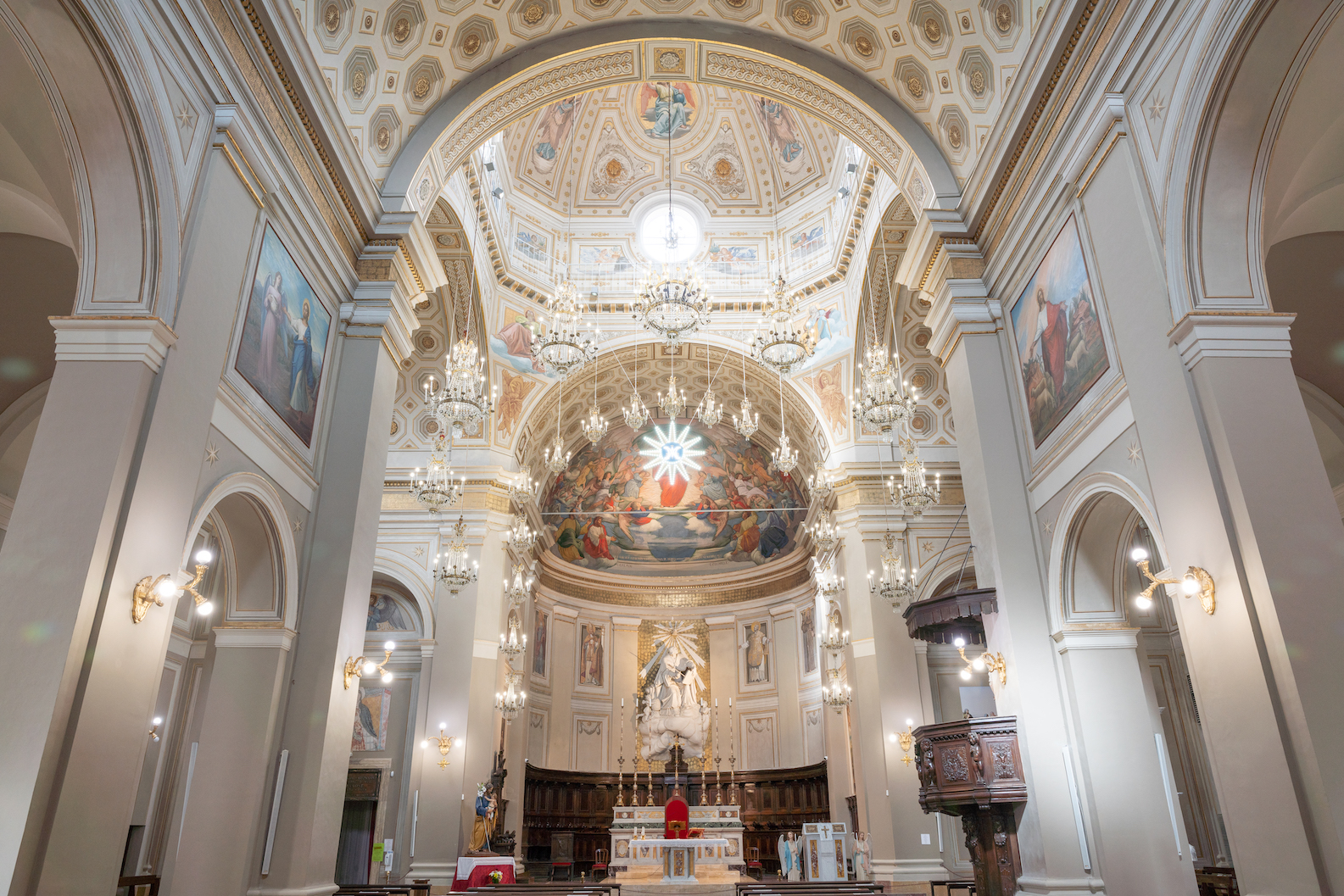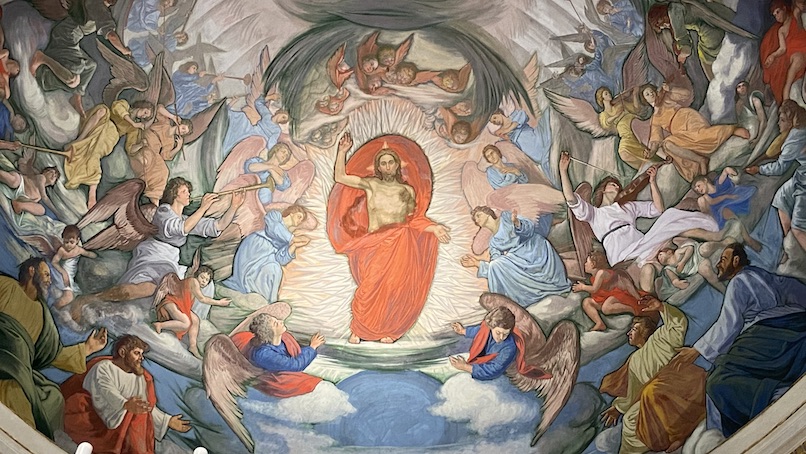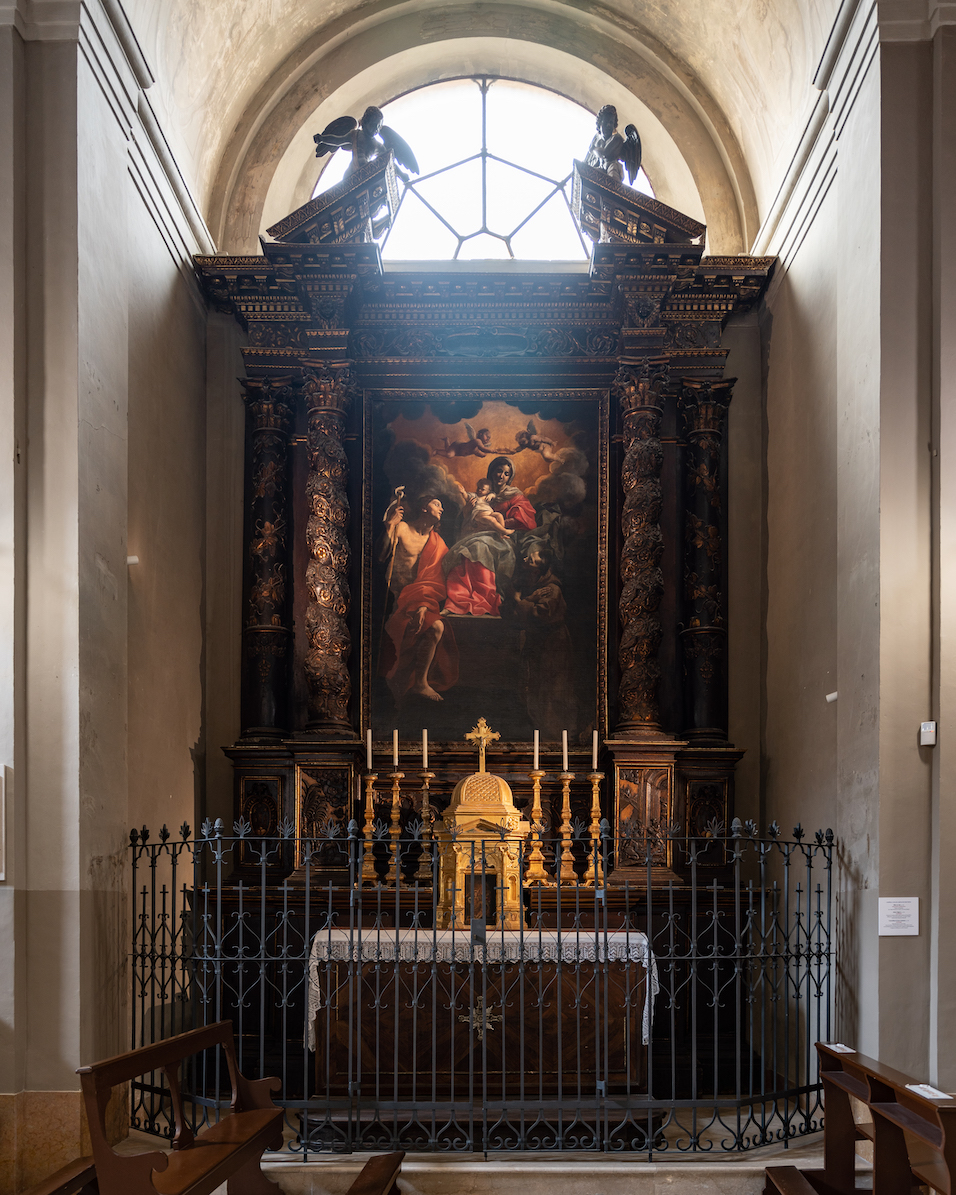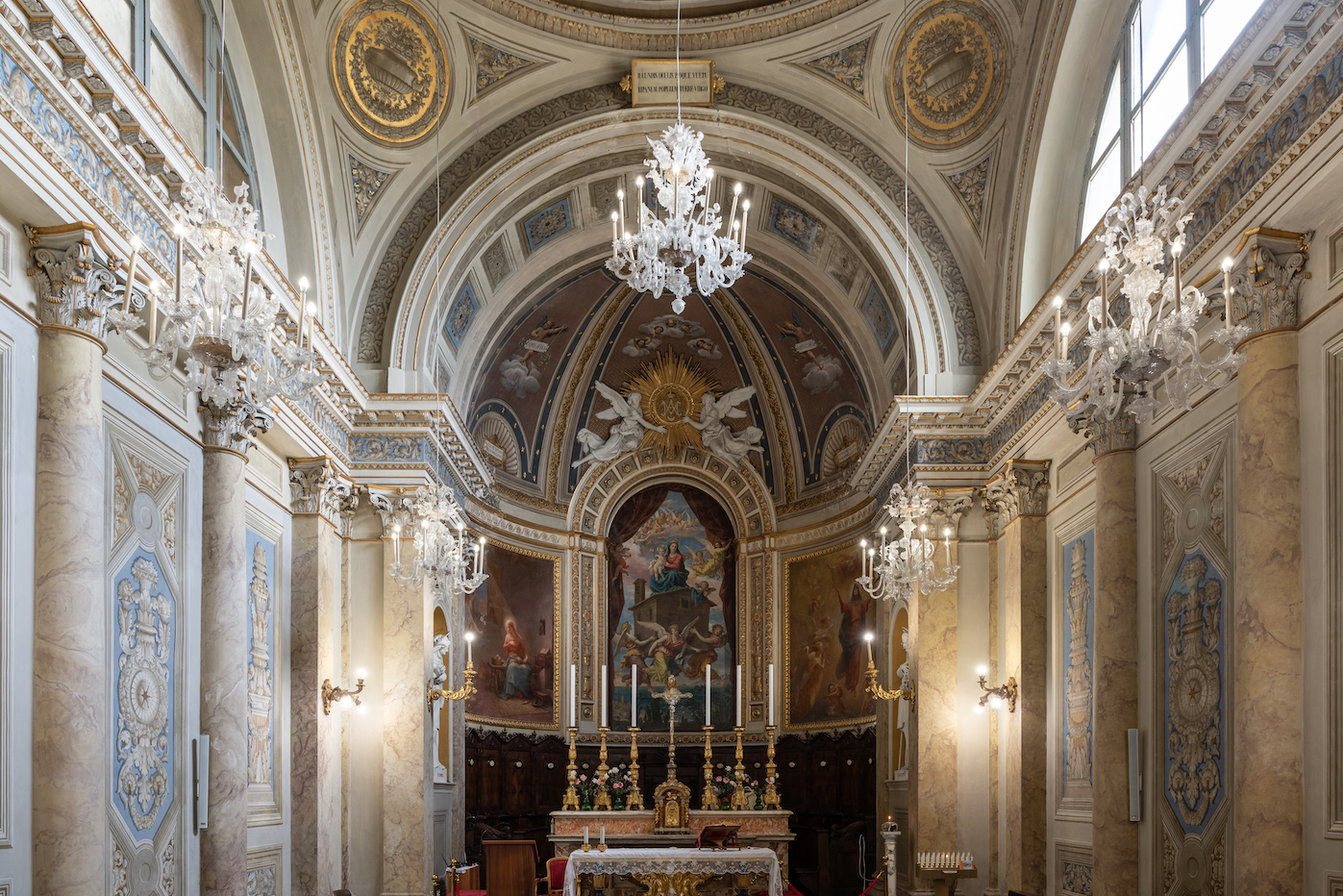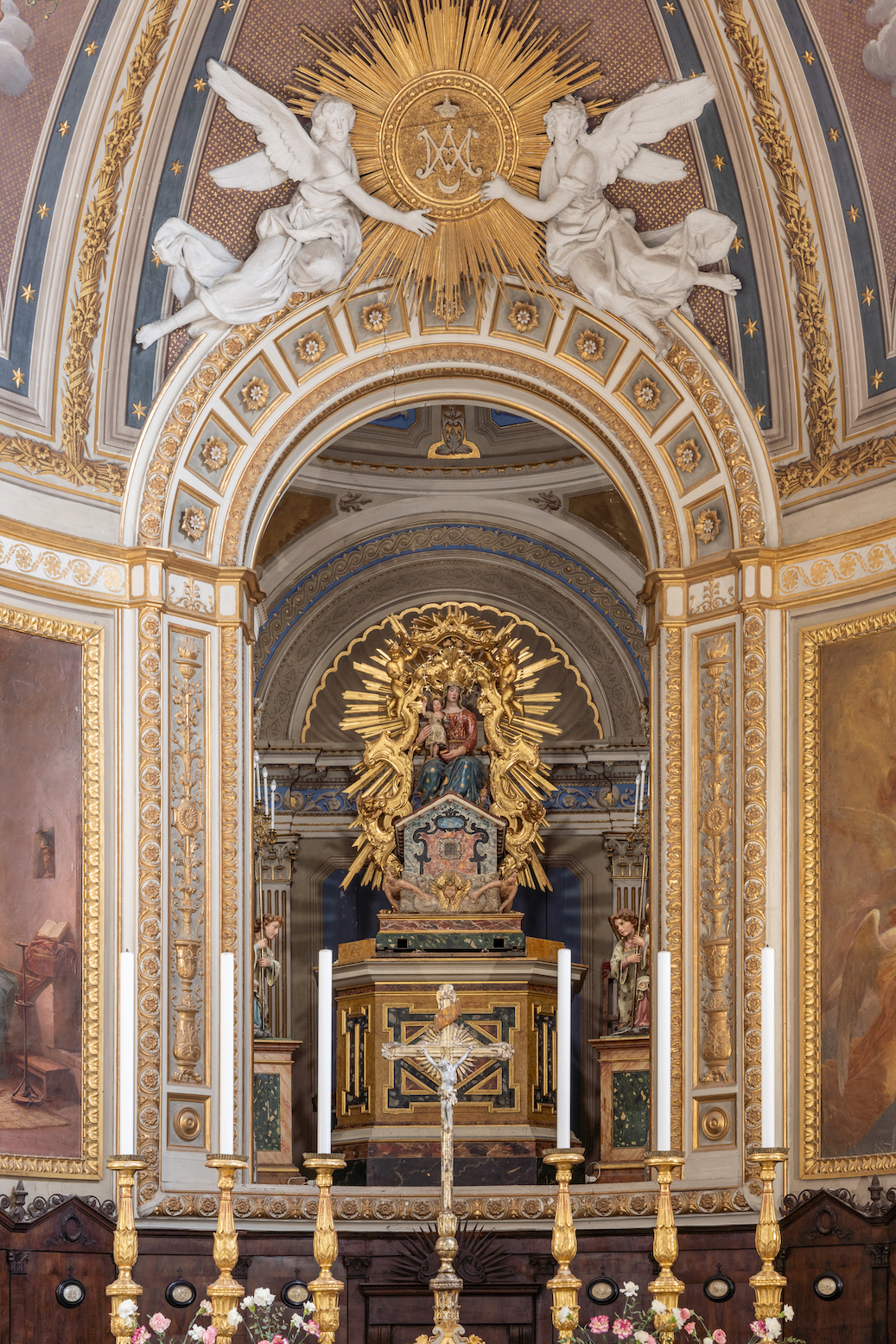The cathedral proper, designed by Gaspare Guerra from Modena, was built from 1597 to 1623; the octagonal tiburium was erected there in 1786, the facade was completed in 1842, the new bell tower was erected in the years 1884-1902, designed by the papal architect Francesco Vespignani: it is 50 m high, on the pyramid spire stands an imposing copper statue of the Redeemer, 4.80 m high, made in 1901 in the Luigi Del Bo foundry in Milan. Consolidation and embellishment works have been carried out there repeatedly; among the works carried out in the second half of the 20th century are those performed on the interior in 1959-60, 1971, and 1972-74; on the exterior those performed in 1987-88 and 1990.
The three-aisled and Latin-cross interior is of grandiose effect especially because of the width and verticality of the nave, transept and tiburium. The new pictorial decoration, replacing the one made around 1849 by the Roman painter and engraver Giuseppe Capparoni, was executed in 1959-60 by the artist Michelangelo Bedini; it moves within the general theme of Christian decoration and reaches very high chromatic levels; the faux coffers were painted in 1960 by Brother Marcantonio.
In the nave, two canvases, depicting the Good Shepherd (right) and the Sower (left), can be seen above. The wooden pulpit (1625) leaning against the last pillar on the right, is the work of Desiderio Bonfini of Patrignone: the dominant motif consists of the elements of the coat of arms of Ripatransone: the lion's paw, the five necks, the lily; in the panels are depicted the five glorious mysteries, starting from the left (little door): the Resurrection of Christ, the Ascension of Jesus, the Descent of the Holy Spirit, the Assumption of the Virgin Mary into Heaven, and the Coronation of the Virgin Mary; in the two telamons, the Dante scholar Canon Galanti (1821-90) saw the face of Dante.
The decoration of the tiburium is rich and varied: at the corners, on the bases and spandrels, the four evangelists with their respective symbols are painted: from the left (clockwise): St. John (eagle), St. Matthew (angel), St. Mark (lion), St. Luke (ox); above, on a background of glittering gold and framed in graceful roundels, the four cardinal virtues are painted: Justice (in the direction of the apse and continuing clockwise), Fortitude, Prudence, Temperance.
The presbytery, partly restructured according to the liturgical provisions of the Second Vatican Council, presents in marble the high altar (executed in 1905 by Poscetti of Rome, dismembered after the new norms) and the ambo; two canvases placed in 1996 on the walls: St. Gregory the Great (probably the work of the Ricci di Fermo, 18th century) on the right; the Nativity (18th cent. 17th century) on the left; the bishop's chair (or cathedra), another masterpiece by Desiderio Bonfini: here the artist reproposes the lion's paw and fleur-de-lis motifs; the best parts are the armrests.
In the apse can be admired: the wooden choir of the canons, a simple but severe work by Agostilio Evangelisti of Ripatransone, made in 1620; the imposing plaster statue of St. Gregory the Great, titular of the Cathedral, a work (c. 1840. ) by Fedele Bianchini of Macerata, a disciple of Canova; on either side of the Holy Pope, the artist Bedini portrayed following classical iconography, the Saints invoked as heavenly protectors of the diocese of Ripatransone: St. James of the Marches, St. Philip Neri, St. Pius V, St. Mary Magdalene. In the apse basin, one can admire Bedini's most successful pictorial complex: the Savior appears in all his majesty; below, in the foreground, the four major prophets (from left): Isaiah, Jeremiah, Ezekiel, Daniel; after the prophets, upward is a view of angels identified by strong lights; other angels treated in strong foreshortening and well drawn follow; the field to the viewer's left is dominated by an angel blowing a trumpet; the fourth plane lets one perceive a crowd of heavenly creatures, who in the midst of the bright light announce the Redeemer.
The liturgical organ is work No. 195 from 1783 by the famous Venetian organ builder Gaetano Callido: it was built for the Church of the Magdalene of the Friars Minor Observant, from where it was moved along with the choir loft in 1812, at the expense of the Confraternity of Our Lady of St. John, and by the organ builder Sebastiano Vici of Montecarotto; from the same church comes the beautiful stoup.
Right aisle
The first chapel was remodeled and embellished with marble in 1959-60; there can be admired the stupendous polychrome wooden Crucifix, donated according to tradition in 1571 by Pope Pius V, when he elevated Ripatransone to the rank of city and capital of the diocese; it is probably by Giovan Battista Casignola of Como, active in Rome at that time. Since Nov. 15, 1990, the mortal remains of Bishop Radicioni and the remains of his parents have rested in the chapel; the prelate is remembered by a copper bas-relief made in the same year by sculptor Aldo Sergiacomi of Offida.
The second chapel is dedicated to St. Mary Magdalene, patron saint of the municipality; the design (1843) is by Gaetano Ferri of Bologna; the gate was made in 1847 at the community's expense by the Ripano forger Gaetano Cellini; the design and gilding are by Emidio Cibatti of Fermo, who moved to Ripatransone; the wooden altar, by M. Angelo Ripano (sec. 17th cent.), was erected by Brandimarte Tommasi (his coat of arms is in the bases of the columns); the altarpiece, depicting the Virgin and Child, St. Gregory and St. Mary Magdalene, is by Orazio Gentileschi Lomi of Pisa, commissioned to be painted by Tommasi himself, for scudi 75; on the walls recently three canvases were placed (municipal property as they came from the church of San Rocco): on the right, Madonna and Child and Saints Peter the Apostle, Rocco, Anthony of Padua, and John the Baptist (by Simone De Magistris of Caldarola, dated 1579); on the left, two small canvases joined together, with the evangelical scene of "Noli me tangere," with the figures of the risen Christ (on the left of the viewer) and Magdalene (on the right), by Luca di Costantino of Ancona (sec. 16TH CENT.).
The third chapel, renovated at the end of the 19th century at the expense of Bishop Nicolai, is dedicated to Our Lady of the Rosary of Pompeii, depicted with St. Catherine of Siena and St. Dominic in the altarpiece, painted in Fossombrone by Ambrosi; the wooden altar was designed and made by Francesco Consorti of Ripano; in the niches are two plaster statues (donated by Colonel Bruti): St. Paul on the right, St. Peter on the left; in the pilasters, also in plaster, two high reliefs (1860) depicting the evangelists who reported on Our Lady, namely St. Matthew (right) and St. Luke (left).
In the fourth chapel (of the cross), the wooden altar, partly gilded, erected by bequest of Carlo Ricci, is the work of Agostilio Evangelisti (sec. 17th century); the altar canvas depicts the chapel's titular saint, St. Charles Borromeo, executed in Rome in 1623, recently attributed to Alessandro Turchi known as l'Orbetto; the two side canvases (1654), St. Paul (right) and St. Peter (left), are attributed to Giuseppe Ghezzi of Comunanza: note the stature of the two saints and the immense drapery of their robes. The chapel is equipped with a rich lipsanoteca.
To the right of the door leading to the sacristies, one can admire the marble monument in memory of canon theologian Adolfo Cellini, raised to him in 1923 by relatives, fellow citizens and admirers: it is the work of Domenico Mastroianni of Arpino. The right aisle leads to the two sacristies, the walls of which are occupied by walnut cabinets made by Sante Morelli of Montegiorgio in the first, and by Ripani Alessandro Angelici (front wall) and Antonio and Emidio Desideri (the other three) in the second, where the painted coffered vault and the central scene, St. Pius V praying to the Virgin Mary, are works by Giuseppe Capparoni (c. 1840).
Left aisle
La Cappella del SS.mo Sacramento fu edificata negli anni 1932-1943 su progetto dell’ingegnere Luigi Anelli; dietro l’altare di marmo fu posta (e si può ammirare tuttora) una tela dell’artista Pasquale Gramolini di Fano: è copia con variazioni del “Sacro Cuore di Gesù”, tela eseguita dal pittore, anche lui di Fano, Giuseppe Luzi (sec. XVIII) per la medesima Cappella del Duomo della sua città.
La terza cappella fu eretta all’inizio del ‘600 da Valentino Giovannini (il suo stemma è alle basi delle colonne), dove fu sepolto; la pala d’altare, la Vergine con il Bambino, Santa Lucia (a destra) e San Valentino, è lavoro di Stefano Ciannavei (secoli XVIII-XIX) di Ascoli Piceno; nelle lesene, due figure dipinte dal sambenedettese Giuseppe Pauri nel 1927: Sant’Agnese (a destra) e Sant’Agata (a sinistra), La cappella è
stata restaurata nel 2002.
La seconda cappella fu eretta dalla Famiglia Marcelli, il cui stemma è visibile nel sontuoso altare in legno (basi delle colonne esterne), con due bassorilievi nelle basi delle colonne interne: Adorazione dei pastori (a destra), Fuga in Egitto (a sinistra); nella pala d’altare, tela di Giovanni Lanfranco (sec. XVII), è raffigurata la Vergine con il Bambino tra San Giovanni Battista e San Francesco d’Assisi. La presenza di un ciborio monumentale in legno dorato (sec. XVI), è dovuta al fatto che per molti anni questa è stata la cappella del SS.mo Sacramento e la sede della parrocchia del Duomo. Sulla lesena di sinistra della cappella, è presente una lapide con epigrafe, che indica il luogo in cui dal 1822 riposano i resti mortali del Servo di Dio P. Simone Filippovich, bosniaco, morto nel Convento-Ritiro della Maddalena di Ripatransone nel 1802; l’ovale in ceramica dipinta, raffigurante il frate “santo”, è opera di Gianni Neve di Centobuchi di Monteprandone (giugno 2002); di fronte, sul pilastro è una lapide “storica” con ritratto, fatta apporre nel 1655 dal vescovo Ulisse Orsini, per indicare il luogo di sepoltura del suo predecessore F. A. Arrigoni (in carica dal 1634 al 1636).
La prima cappella (Battistero), fu ristrutturata e decorata di marmi nel 1959-60, quando il battistero in legno fu sostituito con l’attuale in marmo e coperchio di rame, su progetto di Angelo Gramolini di Fano: dono al parroco Don Filippo Consorti, da parte degli ex alunni (dal 1939 al 1958) dell’Istituto Magistrale Statale “L. Mercantini”.
From the cathedral there is direct access to the Diocesan Shrine of Madonna of San Giovanni, patron saint of the city and diocese of Ripatransone since 1893, and since 1988 of the unified diocese of San Benedetto del Tronto-Ripatransone-Montalto. The entrance door was made in copper in 1950 by Cleto Capponi: in the central right panel is the scene of the thanksgiving service (for the escaped danger during World War II), held in Piazza Condivi on June 25, 1944; in the central left panel is the scene of Our Lady in the act of protecting from above the turreted Ripatransone; in the lower part of the door are two coats of arms, that of the city on the right, that of Bishop Ferri on the left. As the shrine currently stands, it was erected in the years 1846-58, with the design of Fermo architect Giambattista Carducci. The works that can be admired there are: four statues by Luigi Fontana: St. John the Evangelist, St. John the Baptist, St. Joseph, St. Anne (placed in niches); five Murano crystal chandeliers (1889); wall decorations by Antonio Morettini; two-tiered wooden choir, by Sante Morelli of Montegiorgio, in which on April 11, 2003, the 14 small (18 cm wide, including the frame) ivory Stations of the Cross purchased in 1858 by Giuseppe Travaglini, who spent 20 scudi; also in the apse, two canvases executed in 1919 by Roman painter Ballarini, depicting: the Assumption of the Virgin (right) and the Annunciation (left). The centrally planned aedicule, which holds the miraculous Simulacrum (made in 1620 in Recanati by the Camerte Sebastiano Sebastiani), was designed in 1881 by architect Francesco Vespignani; the canvas applied to the large sliding door, was painted by Luigi Fontana: it depicts the Holy House being carried by Angels. Under the choir loft (on which is a liturgical organ made in 1857 by Vincenzo Paci of Ascoli), the Magistrate's Bench, another masterpiece by Desiderio Bonfini (17th century), was moved in 1960 from the cathedral's nave: it is divided into six stalls by seven lions (three remain); in the front, are seven sculptures-caryatids-telamons, depicting the social classes of the early seventeenth century (starting from the left): the beggar, the child, the page, the lady, the squire (almost a Manzonian Don Rodrigo), the commoner, the old man.
